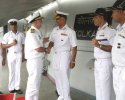MIG - 21 are well known among IAF pilots as a "FLYING COFFINS"...
not the plane's design problem or something actually ,
their airframes are too old to be in service.
not long ago the IAF loved the Mig 21 just as much as they loved the SU 30 MKI
the Flying Coffin , was a name given by the media.
but yeah , they should be replaced as quickly as possible
the following are from the book

"......................................
Another thing that comes out very clearly in the book is that everyone who flew the MiG 21 loved her and considered the aircraft to be a safe and well behaved thoroughbred in which they could beat any other high performance aircraft in combat. Considering that these words have come from at least two people who later became chief of air staff, this information cannot be dismissed lightly as it has been in the lay media who have played an ignorant and unfair role in painting the MiG 21 as an unsafe aircraft.
On the role of the lay media in giving a needless bad reputation to the MiG 21, Air Marshal Satish Inamdar (later vice chief of air staff) writes with some angst saying
“It hurts like hell..this public perception was criminally unfair and contagiously demoralizing both within the air force and outside” . Former CAS AM Tipnis notes that the MiG 21 was used as a trainer (due to the absence of a viable advanced jet trainer. In a moving piece, Tipnis writes, ”The MiG 21 has taken hundreds of pilots onto her lap, taught them, challenged their skills, done their bidding, executed their tasks, brought them indescribable joys, carried them though their occassional crassness and and alas, sometimes succumbed to her own frailty, or to her rider's ineptness. How many of the privileged few, who have tasted the ecstasy of the blue yonder with this trusted mate, have felt they had their maker's final call, but had it adjourned to another day through the blessed stubbornness of our beloved lady to protect her own?
AND this from air commodore Surendra Singh Tyagi
Dispelled myths about MiG 21 being ‘flying coffins’, he said the ‘economies of scale’ worked against the MiG, lending it the disrepute. “In IAF, we gauge safety of a fighter aircraft based on accident rate, which is calculated in terms of accidents per 10,000 flying hours. This rate, at under 0.7 for the most current MiG – the Bison – is no longer alarming as compared with average accident rate for all aircraft deployed by the air force,” he said.
“Earlier, MiG used to comprise nearly 65% of IAF fleet and two of three planes flown are MiGs. Therefore, it registered more crashes than others. Also, most of them were used as training aircraft, in which the chances of human error are higher,” he explained.





